9 Best Telescopes for Beginners | Reviews and Recommendations
June 15, 2020
by Andreea Sterea

The sky above has fascinated humanity since the dawn of time. If stargazing is your passion, quench your space exploration thirst with our selection of best telescopes for beginners! We have 9 telescope reviews and recommendations, together with a complete best telescope buying guide.
No matter how you define things regarding astronomy, the truth is you have always wondered what is up there and how you can unravel the mystery by yourself. Luckily for you, we have a refined selection of 9 best telescopes for beginners to jumpstart your hobby and expand your knowledge and skills.
A beginner telescope adds to that sense of wonder we all experience when faced with the night sky. Nevertheless, to make the best out of such a device, you need to learn a lot. Getting the best telescope is more than selecting a reputable brand. You need to ask yourself what is the best telescope for viewing planets according to a device’s tech specs, in case this is what you are after. On the other hand, the best telescope for astrophotography may not be the best telescope for the money at the same time, so you might want to choose between budget or performance.
If buying the best beginner telescope is your goal (for you, your kid, or the entire family to enjoy), then follow us on our journey to discover what are the best telescopes for beginners.
At the end of this presentation, we will also provide you with a guide to understanding telescopes better so you can make an educated choice. For more information on types of telescopes and explained optical concepts, don’t forget to read our guides and tutorials.
Turn off the lights, science buffs, ’cause the star-seeking journey begins!
| Product Name | Type | Aperture | Mount | Price |
|---|---|---|---|---|
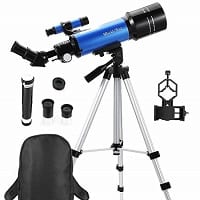 MaxUSee Beginner Telescope
MaxUSee Beginner Telescope
|
Refractor | 70 mm | Equatorial | Check Price |
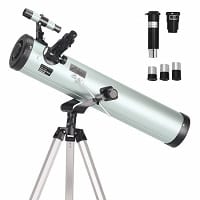 ToyerBee Beginner Telescope
ToyerBee Beginner Telescope
|
Reflector | 76 mm | AZ | Check Price |
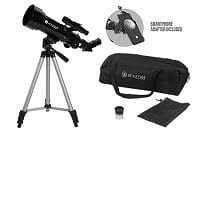 Zhumell Beginner Telescope
Zhumell Beginner Telescope
|
Refractor | 50 mm | AZ | Check Price |
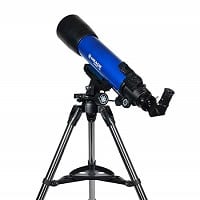 Meade Infinity Beginner Telescope
Meade Infinity Beginner Telescope
|
Refractor | 102 mm | Equatorial | Check Price |
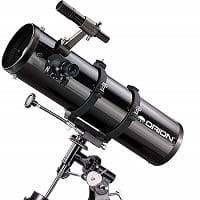 Orion SpaceProbe Beginner Telescope
Orion SpaceProbe Beginner Telescope
|
Reflector | 130 mm | Equatorial | Check Price |
1MaxUSee Beginner Telescope
If somehow the MaxUSee name sounds familiar, it is because we mentioned before when we discussed the best science gifts for kids ideas and reviews. Nothing changed since then. This is still one of the best telescopes for beginners money can buy and children of all ages can enjoy. The best part is that MaxUSee is not a toy. In fact, it comes with compelling tech specs and features to convince beginner adult astronomers to stargaze with its help!
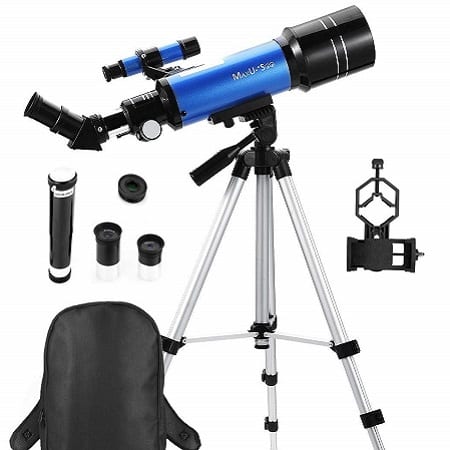
| BEST FOR Teens |
|
| Astronomy Level | Beginners |
|---|---|
| Item Weight | 5.7 pounds |
| Item Size | 16.9 x 11.4 x 5.9 inches |
| What You See | Moon (craters & more), planets. Birdwatching. Sightseeing |
| Type | Refractor |
| Aperture | 70 mm |
| Mount | Equatorial |
| Special Features | 3X Barlow lenses, Moon mirror, Universal Smartphone Adapter, 2 interchangeable eyepieces (K9mm & K20mm), adjustable full-size aluminum tripod, backpack, and binoculars, among others. |
| Warranty | Upon manufacturer request |
Why choose the MaxUSee Beginner Telescope?
As we said back when we reviewed the best science gifts for kids, the MaxUSee telescope is not a child’s toy, but a reliable and trustworthy instrument for astronomical observations and land viewing. It comes with excellent tech specs for its price and plenty of added parts, accessories, and bonuses. In other words, if you are looking for the best telescopes for kids, you can consider this one as well!
Here are some more things you need to know about this beginner telescope:
- It comes with a universal smartphone adapter so you can use your phone for image and video capturing.
- You do not need extra tools to install and use the telescope.
- The adjustable, full-size tripod makes the item a perfect choice for teens and adults alike.
| Pros |
|---|
| Excellent price for the tech specs |
| One of the best amateur telescopes for kids, teens, and adults |
| Portable, lightweight, easy to carry around |
| Comes with Moon map & stars map |
| Cons |
|---|
| Some say it has a flimsy build |
Verdict
The first installment on our best telescope for beginners list makes an excellent choice to introduce kids, teens, and beginner astronomers to this amazing field of science and discovery. The tech specs, the price, the extra items coming in the package and the fun it offers are all compelling reasons to start your journey in the universe with this telescope.
2 ToyerBee Beginner Telescope
With its 76 mm aperture and 700 mm focal length, the ToyerBee telescope for beginners is a small tech piece of jewelry. It allows space and land exploration in a simple, yet effective manner, with clear imagery and easy installation. Kids love it, but students and amateur adult astronomy lovers will find the telescope an excellent investment.
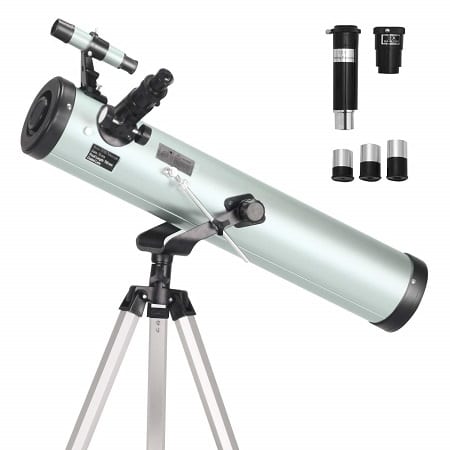
| BEST FOR Learning | |
| Astronomy Level | Absolute Beginners |
|---|---|
| Item Weight | 10.3 pounds |
| Item Size | 26.6 x 30.7 x 54 inches |
| What You See | Moon’s craters, Jupiter’s major moons, Saturn’s rings, etc. |
| Type | Reflector |
| Aperture |
76 mm. |
| Mount | Equatorial |
| Special Features | 3 eyepieces (H20mm, H12.5mm and H4mm), one 2X Barlow lens (35X to 350X magnification), finder scope with bracket, Moon mirror, etc. |
| Warranty | 3 years |
Why choose the ToyerBee Beginner Telescope?
You can consider this telescope as the introductory phase of your astronomy hobby. We chose it for its tech specs (namely the aperture, Moon mirror, and the eyepieces) as an excellent instrument for learning how telescopes work and what you are supposed to do with them before you move onto a more advanced model. The ToyerBee telescope is for the absolute beginner who is eager to absorb astronomy knowledge in a fast, reliable, and efficient manner.
Here are some more things you need to know about this item:
- The manufacturer offers a full set of paper and video installation guidelines.
- The telescope rotates 360 degrees.
- The 1.5X erecting eyepiece, 2X Barlow lens, finder scope mounting bracket, the adjustable aluminum tripod, and manual make the telescope an incredible stepping stone in your astronomy hobby and an amazing teaching/learning tool for kids and teens as well.
| Pros |
|---|
| Great apperture for beginners |
| Offers clear views of Moon, planets, and interesting celestial objects |
| Easy to install & use without extra tools needed |
| Good price |
| Cons |
|---|
| Some complained about pieces missing from the package |
Verdict
When you buy your first telescope without knowing anything about them, you should look for an item with a good price and plenty of learning value. We are happy to report that the ToyerBee telescope for beginners (include here children and teens as well) matches the criteria and passes the test with flying colors.
3 Zhumell Z50 Beginner Telescope
How would you like to have an amazing telescope at half the price of its peers? The Zhumell beginner telescope packs a big punch in terms of tech specs but an unbeatable price nonetheless. It is a compact and reliable item that will introduce you smoothly and efficiently in the world of astronomy.
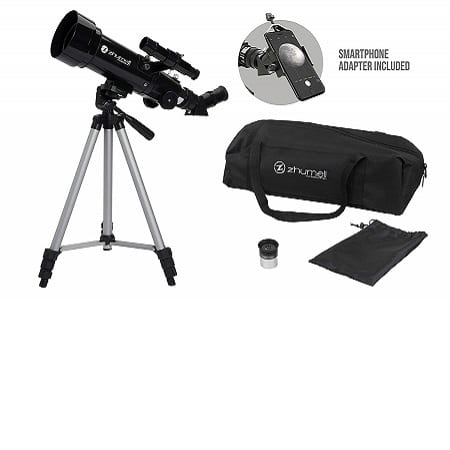
| BEST FOR Price/Value Ratio | |
| Astronomy Level | Absolute Beginners |
|---|---|
| Item Weight | 2.3 pounds |
| Item Size | 20.5 x 8.5 x 6.5 inches |
| What You See | Moon, planets, land objects |
| Type | Refractor |
| Aperture |
50 mm |
| Mount | AZ |
| Special features | Erect Image Optics, smartphone adapter for photo/video, 20mm eyepiece, 8mm eyepiece, 2×20 finderscope, a 1.25″ visual back, 3 x Barlow, duffle bag. |
| Warranty | Upon request from the manufacturer. |
Why choose the Zhumell Z50 Beginner Telescope?
While it is true that the larger the aperture, the better the image, Zhumell Z50 does not disappoint when it comes to allowing you fast, clear, and breathtaking views of the Moon and stars above. For children and absolute beginners in stargazing, it is one of the best amateur telescopes your budget can cover. And we do not have to tell you it comes with an unparalleled price given its features. This devices makes it to the category best telescope for the money with flying colors.
Let’s see some of its best tech specs and features:
- The Erect Image Optics determine right-side-up images, perfect for day-viewing terrestrial objects like nature and wildlife
- It is small, compact, and sturdy, so you can grab it and go on your next discovery adventure
- Comes with an adjustable tripod.
| Pros |
|---|
| Excellent price for beginner telescopes |
| Clear views of celestial and land objects |
| Enthusiast users' reviews |
| Cons |
|---|
| The manual could contain more detailed instructions |
Verdict
Children, teens, and absolute astronomy beginners will love this small and versatile telescope. Some may not know if they keep the hobby for longer times, so they do not want to over-invest in a fleeting passion. You can rest assured that the money spent on the Zhumell Z50 won’t lead to any regrets. On the contrary, the telescope does a wonderful job despite the 50 mm aperture. Recommended wholeheartedly by all enthusiast stargazers.
4 Meade Infinity Beginner Telescope
Let’s take things up a notch with our list of best telescopes for beginners, shall we? This next entry is an item that works amazing for both amateurs and those who want to pass the beginner threshold fast to reach the intermediate level. Meade Instruments is a reputable brand and this telescope does not fall far from the tree either.

| BEST FOR The Whole Family | |
| Astronomy Level | Beginners to intermediates |
|---|---|
| Item Weight | 12.2 pounds |
| Item Size | 34 x 34 x 53 inches |
| What You See | The solar system with Moon, Saturn rings, Jupiter moons, nebulae, other celestial or land objects. |
| Type | Refractor |
| Aperture | 102 mm |
| Mount | AZ |
| Special Features | Altazimuth mount with panhandle and slow-motion controls, 600 mm focal length, 3 x magnification eyepieces, 2 x Barlow lens, red dot viewfinder, astronomical software, and instructional DVD, etc. |
| Warranty | 1 year |
Why choose the Meade Infinity Beginner Telescope?
As we said, Meade Instruments makes high-quality, reliable products. The Meade Infinity is the best telescope for beginners who want to up their ante and enjoy the full benefits of a product with excellent tech specs. We said it was the best telescope for the whole family. By that we mean the Meade is versatile enough to help children and teens develop their enthusiasm for astronomy and adults to power up their space exploration hobby.
Let’s learn a few more things about this telescope!
- It features 3 eyepieces providing low, medium and high powered magnification for viewing a wide range of sky or land objects.
- As a bonus, you receive the Autostar Suite Astronomy planetarium DVD with over 10,000 celestial objects (Windows only).
- Features right-side-up image for day viewing.
| Pros |
|---|
| Excellent aperture for beginners and intermediates |
| Great choice for both night & day viewing |
| Good price for the tech specs |
| Enjoyable by the entire family |
| Cons |
|---|
| Could benefit from an extended warranty |
Verdict
This telescope addresses teens, students, and adults who know a thing or two about stargazing and want more. It is also an incredible educational tool for parents who want to nurture the passion for astronomy in their kids’ hearts. You can imagine that the 102 aperture allows superb celestial objects’ viewing, sparking that powerful sense of wonder and thirst for discovery you want your child to experience. It is one – if not the – best telescope for viewing planets in its price and level range.
5 Orion Space Probe Beginner Telescope
The serious beginner astronomy aficionados will have a field day with this one. Orion makes some of the best telescopes for beginners and professionals alike, and the Space Probe 130 ST is a dream came true. With excellent aperture and its many features, this telescope will feed your stargazing addiction and propel you to the next level.
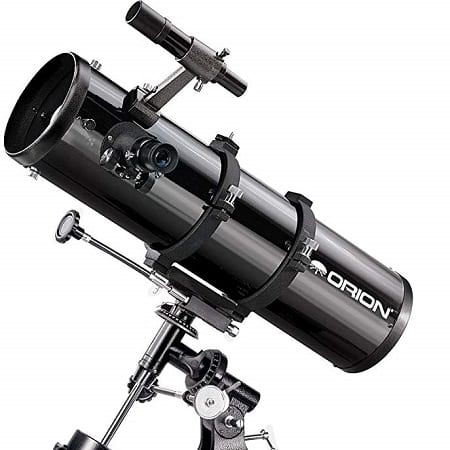
| BEST FOR Bright deep space exploration | |
| Astronomy Level | Beginners to intermediates |
|---|---|
| Item Weight | 24.2 pounds |
| Item Size | 24 x 24 x 51 inches |
| What You See | Moon, planets, brighter galaxies, nebulas, and star clusters |
| Type | Reflector |
| Aperture | 130 mm |
| Mount | Equatorial |
| Special Features | Fast f/5 focal ratio for wide-field performance, 2 x 1.25 inch Sirius Plossl eyepieces (25mm and 10mm), 6×30 finder scope, 1.25inch rack and pinion focuser, tripod accessory tray, collimation cap, adjustable tripod for manual slow-motion tracking of celestial objects, Starry Night astronomy software, etc. |
| Warranty | 1 year |
Why choose the Orion Space Probe Beginner Telescope?
Crystal clear and sharp images, deep bright sky exploration, reputable brand, and reasonable price for the specs – this would be the short definition of the Orion Space Probe telescope. Just as the manufacturer says, it is still a beginner’s telescope but dedicated to beginners wanting to gaze deeper and farther. This telescope is one of the best Orion telescopes for beginners. Let’s see some tech specs to understand why the Orion Space Probe is one of the best telescopes for deep space viewing.
- It features 650 mm focal length, 260x highest useful magnification, two Plossl eyepieces and included 6×30 finder scope to accurately aim the SpaceProbe 130ST reflector at objects in the near or deep sky.
- The telescope comes with the free Special Edition of Starry Night astronomy software (realistic sky simulations and telescope control, among others) to help you plan observations and understand what you see.
- The 24 inches long “Short Tube” optical tube design provides with easy portability.
If you ever wonder what is the best telescope for viewing planets and understand how to approach astronomy and celestial observations, this orion telescope will bring you closer to your goal (and answers to your questions).
| Pros |
|---|
| Great tool for bright deep space exploration |
| Wide field of view, excellent aperture |
| Sturdy and precise EQ-2 equatorial mount with dual setting circles and slow-motion hand controls |
| Good price |
| Cons |
|---|
| Pro astronomers will opt for a more hi-tech model |
Verdict
If nebulas and other space oddities are the droids you are looking for, then the Orion Space Probe is a stepping stone in your quest for deep sky answers. You will not probably see any aliens, but with its aperture, focal length, and free learning software, this telescope will certainly meet and even exceed your expectations. One of the best telescopes for beginners in its price range as well!
6 Celestron NexStar 6 SE Beginner Telescope
In truth, the iconic “orange tube” features enough hi-tech specs to please even the most sophisticated of beginner or advanced astronomers. The Celestron NexStar 6 SE is an impressive piece of equipment and one of the best telescopes for deep space viewing. Let’s see what it is all about!
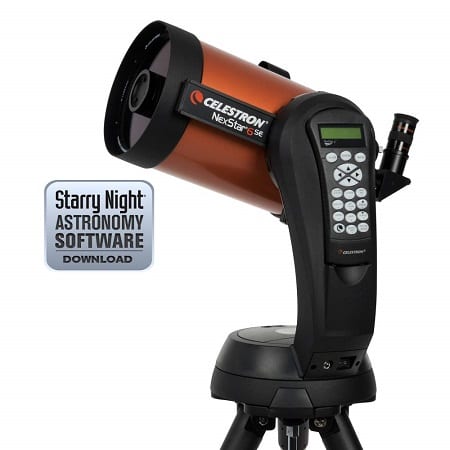
| BEST FOR Hi-Tech Deep Space Viewing | |
| Astronomy Level | Beginners & Advanced |
|---|---|
| Item Weight | 21 pounds |
| Item Size | 32 x 26 x 12 inches |
| What You See | Saturn’s rings with Cassini’s Division, cloud bands on Jupiter, Moon geographic features, Orion Nebula, the Hercules Globular Cluster, the Whirlpool Galaxy’s spiral arms, etc. |
| Type | Catadrioptic |
| Aperture |
150 mm |
| Mount | Motorized AZ |
| Special Features | Fully automated GoTo mount with database of 40,000+ celestial objects, a focal length of 1500 mm, 10 focal ratio, SkyAlign technology, unique single fork arm design, sturdy steel tripod, Celestron Starry Night Special Edition software (PC and Mac), etc. |
| Warranty | 2 years |
Why choose the Celestron NexStar 6 SE Beginner Telescope?
This particular Celestron model is a legend among amateur and advanced astronomers. While it is the most expensive beginner telescopes on this list, it is worth every cent, especially due to the impressive aperture and the proprietary StarAlign technology dedicated to deep space observations. In case you did not know, the Celestron NexStar 6 SE is one of the best Celestron telescopes on the market and you could never go wrong with it, whether you are a beginner or at a medium-level.
Let’s look at the details, shall we?
- This Schmidt-Cassegrain optical system features a highly performing altazimuth computerized mount.
- The fully automated GoTo mount comes with a database of 40,000+ celestial objects and it automatically locates and tracks them for you.
- The SkyAlign technology allows you to align your telescope even if you do not know anything about the night’s sky.
- You can download the Starry Night Special Edition software free on your PC or Mac and enjoy deep space learning experiences.
- Once you buy this telescope you will not need an upgrade any time soon, unless you go pro.
| Pros |
|---|
| Amazing tech specs and features |
| Easy installation and portability |
| Very high educational/instructional value |
| A good long-term investment for serious astronomy beginners |
| Impeccable brand reputation |
| Cons |
|---|
| Very expensive |
Verdict
Add together the 150 mm aperture, Schmidt-Cassegrain optical tech, 1500mm focal length, computerized GoTo mount, a revolutionary SkyAlign alignment technology, a sky tour feature, a database of over 40,000 celestial objects, and easy-to-use hand controls and you clearly understand that the Celestron 6 SE is in a league of its own you want to join now if you are the dedicated astronomy hobbyist. One of the best telescopes for beginners and probably the best telescope for astrophotography and astronomical education, the Celestron is a must-have at all ages and levels!
7 Levenhuk Skyline Beginner Telescope
If the name Levenhuk sounds familiar, you are right. You heard about it when we presented you with the best science gifts for kids to get this year. Back then, we were talking about the Levenhuk microscope, but the company is a legend when it comes to optical technology, so the Skyline telescope is yet another of this brand’s technological jewelry piece.
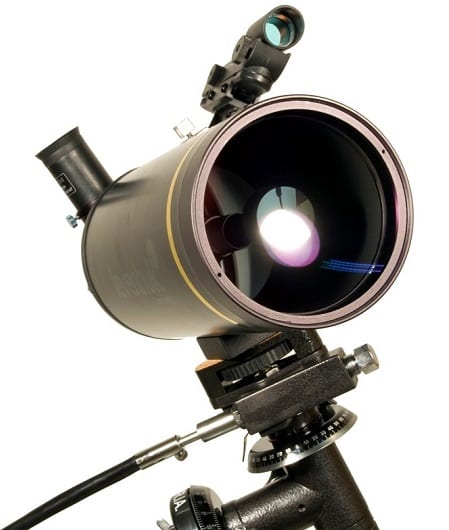
| BEST FOR Astrophotography | |
| Astronomy Level | Beginners to Advanced |
|---|---|
| Item Weight | 20 pounds |
| Item Size | 39.8 x 17.7 x 10.6 inches |
| What You See | Solar System objects, deep space objects, land viewings |
| Type | Reflector |
| Aperture |
102 mm |
| Mount | Equatorial |
| Special Features | Maksutov-Cassegrain optical design, 1300 mm focal length, Red Dot finder scope, adjustable tripod, focuser with a standard T-thread for SLR cameras, etc. |
| Warranty | Lifetime |
Why choose the Levenhuk Skyline Beginner Telescope?
Besides nigh sky observations, most hobbyists also feel an inclination towards astrophotography. Well, if you have an SLR camera and you are serious about capturing on film the breathtaking celestial objects you see with the telescope, then the Levenhuk Skyline is for you. One of the best telescopes for astrophotography on this list, the Skyline also comes with other interesting features you should consider:
- The fully multi-coated optics of this model offer sharp and clear viewings of deep sky objects and terrestrial ones as well.
- The German equatorial mount works in perfect cohesion with the Red Dot finder to make the locating and tracking of celestial objects a breeze.
- The telescope also comes with 2 eyepieces (10 mm and 20 mm), diagonal mirror, tripod, and lifetime warranty.
| Pros |
|---|
| Excellent telescope for astrophotography |
| Good price for the hi-tech specs |
| Easy to install and use |
| Lifetime warranty |
| Cons |
|---|
| May be a bit expensive for absolute beginners |
Verdict
Given the price range and its tech specs, plus the lifetime warranty and its compatibility and ease of use with SLR cameras, the Levenhuk Skyline is one of the best telescopes for astrophotography and one of the best telescopes for deep space viewing. We recommend it wholeheartedly, especially if you want to move fast from beginner level to advanced.
8 Orion StarBlast Beginner Telescope
Did you ever wish to be one of the explorers of the past and spend your days in a sumptuous office filled with land and sky maps, binoculars, a tabletop telescope, old books, and paper scrolls? Your wish may come true with the Orion StarBlast telescope, a small but powerful piece of tech to quench your thirst for uncovering the universe’s mysteries. Let’s see why the Orion StarBlast is one of the best telescopes for beginners!
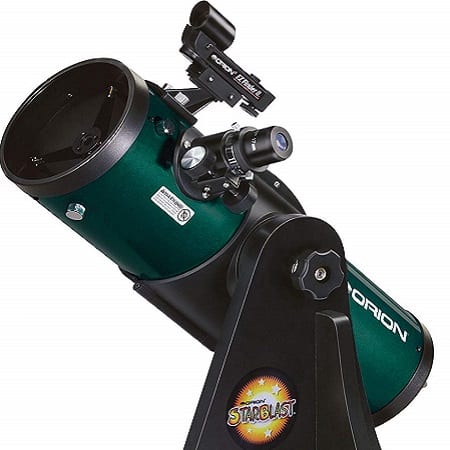
| BEST FOR Tabletop | |
| Astronomy Level | Beginners to Intermediates |
|---|---|
| Item Weight | 13 pounds |
| Item Size | 23.5 x 18.5 x 25 inches |
| What You See | Moon mountains and craters, Jupiter and its moons, Saturn’s rings, bright galaxies, distant cloudy nebulas, sparkling star clusters, etc. |
| Type | Reflector |
| Aperture |
114 mm |
| Mount | AZ |
| Special Features | Fast f/4 focal ratio, 450 mm focal length, wide field of view, stable tabletop base for easy AZ tracking, 2 Explorer II 1.25 inch Kellner eyepieces (17mm and 6mm), EZ Finder II reflex sight for easy aiming, eyepiece rack, Starry Night astronomy software, etc. |
| Warranty | 1 year |
Why choose the Orion StarBlast Beginner Telescope?
Who doesn’t want a tabletop telescope with excellent tech specs that they can also grab and go for a night sky viewing session? The Orion StarBlast makes beginners’ and intermediates’ dreams come true. If you want more suggestions on Orion telescopes and how to pick the best one for your needs, check out our Orion telescope reviews and recommendations!
But let’s see other reasons why you should give this piece of wonder a chance!
- Compact, lightweight, easy to install and use for the entire family to explore their inner astronomer.
- With its precisely crafted, wide-field f/4 reflective optics and significant 4.5 inches (114mm) aperture, the telescope will offer you crystal-clear views of deep-sky objects as well.
- It comes pre-assembled, so you can take it from the box directly to the table or back yard!
| Pros |
|---|
| Versatile tabletop/grab-and-go telescope |
| Excellent price for the tech specs |
| Works well for beginners and intermediates |
| Excellent users' reviews |
| Cons |
|---|
| Some say you can only see the Moon with it |
Verdict
As we said above, Orion is a brand you can trust when it comes to the best telescopes for beginners and even advanced astronomers. It works for children as well because it is compact, lightweight, and ready to go from the package. The Starry Night software is an excellent learning/teaching instrument. For the price and the specs, you cannot go wrong with it, that’s for sure!
9 Gskyer AZ 70400 Beginner Telescope
The last entry on our list of best telescopes for beginners is the Gskyer AZ 70400 model, an ultra-clear refracting telescope to meet and exceed the expectations and requirements of all adventurers out there. Watch the cosmos and take a clear and deep peek at the terrestrial world around you with this grab-and-go telescope!
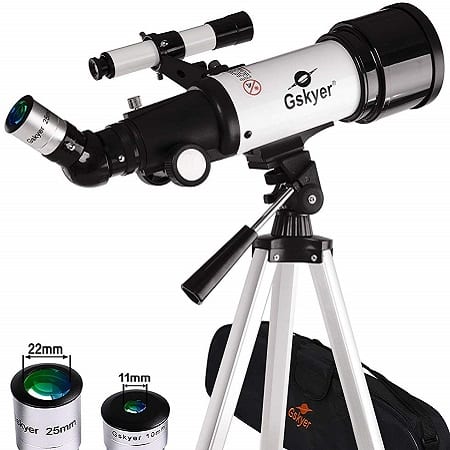
| BEST FOR Travel & Adventure | |
| Astronomy Level | Beginners |
|---|---|
| Item Weight | 5 pounds |
| Item Size | 26 x 8.3 x 4.9 inches |
| What You See | Celestial objects (Moon, Saturn rings, etc.), land objects and events |
| Type | Refractor |
| Aperture | 70 mm |
| Mount | AZ |
| Special Features | Two replaceable eyepieces (16X, 40X), 5X24 finderscope with mounting bracket and cross line, backpack and carry bag for easy transportation, etc. |
| Warranty | 1-year warranty and lifetime maintenance |
Why choose the Gskyer AZ 70400 Beginner Telescope?
…because you are an adventurer and you want to take your telescope hiking. It is a wonderful piece of tech if you want to observe the night’s sky and also sports events, concerts, outdoor sports, and more. The price is incredible for what this little compact telescope can do, but let’s see other features astronomy beginners might enjoy!
- It features 400 mm focal length, 2 eyepieces, Antireflection Blue Film optical coating, 3x Barlow lens, adjustable aluminum alloy tripod, and inverted image Star Finder, among others.
- No-tools setup and easy installation.
- Grab it and go to the mountains for clear sky and superb nature/sports observations.
| Pros |
|---|
| Great price |
| Excellent for back yard and camping fun |
| Good tech specs and high portability |
| Enthusiast customers' reviews |
| Cons |
|---|
| Not-so-great customer service |
Verdict
For its small price and good tech specs, the Gskyer telescope is a wise choice to make for a beginner, especially if you want to take it with you on your outdoor adventures. Naturally, if you want to see more than the Moon and some bigger celestial objects, you should consider the more advanced models we put on this list. Nevertheless, we recommend it as one of the best telescopes for beginners when it comes to families who spend a lot of time outdoors and on adventures, as it makes a fun, lightweight, and educational tool to have around. If you are into outdoor explorations, adventure, and learning, feel free to check out our guide on the best spotting scopes for all levels!
Beginner Telescope Buying Guide: All You Need to Know
Astronomy is probably one of the most complex and (still) enigmatic science fields out there. While a select few can actually fly up there and spend time there in space, the rest of us mere mortals on Earth need telescopes to discover the mysteries of the sky. While a telescope will not give you access to the ISS to see what astronauts do and do not do out there – nor make it possible for you to see some of the craziest phenomena in space – they are the surefire way to teach you plenty about our celestial neighborhood.
Buying the best telescope for beginners and hobbyists is not an easy feat, as you need to understand how the technology works and what specifications you need to consider in your purchase.
To help you make the best decisions for your needs, we offer you the following guide on how to buy the best amateur telescopes for you, kids/teens, or the entire family to enjoy! If you want to learn more about optical concepts and what a telescope can and cannot do, we recommend you read our guide on how telescopes work and Andrea’s tutorial on types of telescopes.
The Basics of Beginners Telescopes’ Tech Specs
During this article, you have seen plenty of numbers and words that might not tell you anything. So let’s break things down a little!
1. Aperture
The aperture size is the most important feature you need to consider when you buy a telescope, beginner or otherwise. A telescope works by gathering as much light as it can to focus it to a certain point.
- The eyepieces you receive with your telescope magnify the image the telescope focused so you can see celestial objects’ details or distant objects clearly.
- If you want to see very distant objects at high levels of detail, you need more light.
- To get more light, you need a larger aperture.
As you can see, this particular feature confirms the saying that (in some cases, at least), size does matter. The bigger the aperture, the more advanced the telescope is and the more you see. Consider aperture when you want to buy the best telescope on the market – either for beginners or advanced hobbyists. Moreover, whenever you want to learn what is the best telescope for viewing planets, factor in aperture and a few of the following tech specs.
2. Focal Length
The focal length represents the total distance between your telescope’s focal point to its lens/mirror.
- Size does matter in this case too – the bigger the focal length, the bigger and clearer the celestial objects will be;
- If you have to choose between large aperture size and large focal length size, go for aperture.
3. Magnification
Everyone with a camera or even a smartphone understands the concept of magnification. However, before you buy a beginner telescope, make sure you have the right aperture and focal length because if the image is not clear, no amount of magnification will satisfy your needs of seeing celestial objects (which will appear blurry in the best-case scenario). The best telescope for astrophotography should feature a balanced blend of aperture, focal length, and magnification.
2. Types of Telescopes
In short, when you look for the best telescope for beginners or advanced astronomers, you are likely to find three major types of telescopes:
- Refractor telescopes – they use lenses to allow you to gaze into the heavens above. Some telescopes come with 2 such lenses, others (more advanced), may come with four.
- Reflector telescopes – instead of lenses, they use mirrors to gather the light and focus it onto an eyepiece. In your searches, if you stumble upon the term Newtonian telescope, you should know it is the most common type of reflector telescope available.
- Catadioptric telescopes (compound) – they represent a combination of the two styles above as they use both lenses and mirrors to gather light and focus it and allow you to see the deep sky. You will also find the term Cassegrain (Schmidt- and Maksutov-) optical design when you look for catadioptric telescopes.
At some point in life, every amateur astronomer owns a Cassegrain telescope, but the difference between the Schmidt-Cassegrain and the Maksutov-Cassegrain designs make the content of another article, dedicated to advanced and pro astronomers.
In short, the Maksutov – Cassegrain telescope design is similar to the Schmidt – Cassegrain telescope. However, the former is an upgrade of the latter, featuring more spherical corrector lenses.
3. Telescope Mounts
The mount of a telescope is a rather overlooked feature, but you should consider it before you make any purchase. When you use a telescope you want two things happening at the same time:
- A smooth, controllable movement so you can guide the telescope and point it towards the objects of your interest;
- Solid support for the telescope so you can see clear images and take sharp pictures.
For both conditions to be simultaneously met you need a mount. It allows the telescope to move freely and point around two perpendicular axes (always at right angles). There are two types of telescope mounts:
- Equatorial – the equatorial mount (EQ) allows you to aim the telescope at a celestial object and track it in its daily motion as the Earth rotates around its axis. The EQ mount keeps the focused celestial object in your eyepiece even if the Earth moves.
The EQ mount is the best choice if astronomy and astrophotography are your passions and you want to make the best out of your astronomical telescope. When you look for the best telescope for astrophotography (beginner or advanced level), look for a model with equatorial mount. You will find such models among Orion telescopes and Celestron telescopes, two legendary brands that make some of the best telescopes for all levels.
- Alt-Azimuth – the AZ mount allows you to see deep in the space, but as the Earth rotates, celestial objects will seem to move across the sky, fading away from your eyepiece. If you feel adamant in your deep space explorations, you can turn an AZ mount into an EQ one with the use of a wedge (in some models).
However, AZ mounts are the ones to buy when you want to observe terrestrial objects. For more information on terrestrial observations, read our guide and reviews for the best spotting scopes on the market!
What Else Should You Know Before You Go on Buying one of the Best Telescopes for Beginners?
Before you go buy a telescope, the first thing you need to do is set your expectations accordingly. While we have all seen images of planets, galaxies, and deep sky objects, observing them in real time with your own eyes can be a life-changing experience.
However, set your expectations straight. You will never get Hubble-level images of star clusters, distant galaxies, nebulas, and other mind-bending cosmos objects with a beginner’s telescope.
- Realistic expectations mean to understand and fully enjoy what your telescope can show you.
- The good news is that the modern ones – that we already put on this list – have plenty to offer. If that supermassive black hole is missing from your inventory, you should not be disappointed. On the contrary, enjoy the Moon’s terrific geography, bright sky objects, planets with amazing details (like Jupiter’s moons and Saturn’s rings), and every little object your telescope shows you on a clear night.
Besides expectations, you should also analyze your level of commitment and responsibility towards your beginner telescope, as it needs care and maintenance.
- Make sure you dust the lenses with special brushes;
- Spills and spots go away with special telescope lenses’ cleaning solutions;
- If you want to clean the mirror of a telescope, make sure you can disassemble and reassemble it correctly and with no accidents.
A Few More Tips on How to Use the Best Beginners Telescopes for A Fulfilling Astronomy Experience
Before we leave you to your purchasing decision regarding the best telescope on this list, we want to offer you a few tips on how to use your new astronomy tool at the best of its capabilities so you can have the utmost of fun with it!
- Use the telescope in open, large areas with no buildings around;
- Of course, clear nights with no clouds, pollution, smog, or urban lights are the best for your discoveries;
- Some overlook this advice but don’t look at the stars with the telescope through your house window, as the image quality suffers significantly. If you do not have a choice and have to look through the window, understand that the window acts as a lens, so at least aim the telescope directly through the said window (don’t aim it at an angle, you will not get the desired results);
- If you get a telescope with bonus software for stargazing, make the best out of the program and use it as an educational tool;
- Most manufacturers say this, but we feel we should emphasize on it: never aim your telescope directly at the sun!
- Try looking at celestial objects through the corners of your eyes – you may even see faint distant objects that would be otherwise invisible.
Best Telescopes for Beginners: The Bottom Line
We hope you enjoyed our selection of best telescopes for beginners and our short guide on how to buy and use them. If you already have a beginner telescope, share some of your best experiences with it. If you are considering purchasing one, tell us which model on this list appealed to you the most! Happy stargazing, everyone! If you have other products you consider to be the best telescope for beginners, let us know and we will make our best to offer you more telescope reviews! Also, if you have more suggestions for our telescope buying guide, feel free to ask your questions or offer your scientific knowledge on how telescopes work!
Want more science now?
Check out our news page where we post interesting studies and discussions (sometimes mocking them mercilessly) for more.
